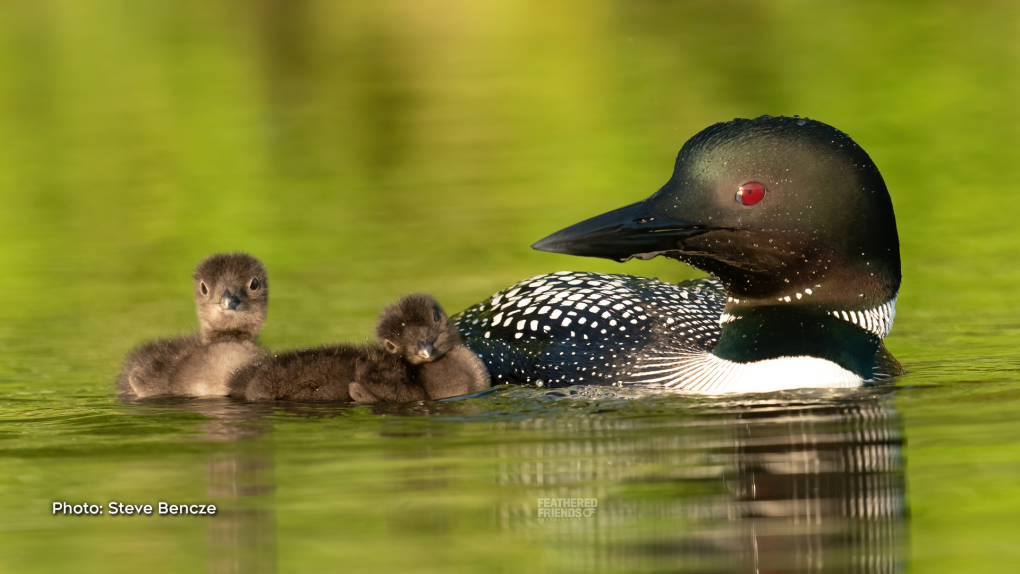Birds Canada continuing to monitor loon population
It doesn't get any more Canadian than the loon, a bird that is an iconic part of the northern Ontario landscape. But some people on Manitoulin Island say they aren't seeing them as much.
Ray Bernstein, who lives on the North Channel, said their absence has been a source of disappointment.
 Loon family. (Steve Bencze/CTV Viewer)
Loon family. (Steve Bencze/CTV Viewer)
"Typically, we see loons here all year, like during the summer. And this year, we haven't seen any," said Bernstein.
A photographer by trade, he built his Little Current house 13 years ago. Bernstein said seeing the loons on his property is part of the charm.
"I don't think they're necessarily gone from the region, but they're gone from right here," he told CTV News in an interview.
Kathy Jones, the volunteer manager for Birds Canada, said she's not surprised loons aren’t around.
"From my perspective, I'm hoping people aren't seeing very many right now because they should still be on the lakes," said Jones.
"There's only going to be one or two here or there."
Jones, who predominantly works on the Canadian Lakes Loons Survey, said loons are a long-lived bird and it's incredibly difficult to track the adult population.
Birds Canada knows there are fewer chicks and that has some people concerned.
"I think there's a lot of potential here for trouble (because) they are sensitive," said Jones.
"We know that they're very sensitive to climate change, we know that they're sensitive to warmer waters. They're a great species to see what's wrong with our lakes because if there's something wrong with the lake they raise chicks on, the chicks won't survive."
Because they live so long, she said adults can keep producing chicks for many years.
"Then suddenly you may not have many adults left because the adults are not replaced because the chicks are not surviving," said Jones.
"We don't know the population level well – it's not something we can track. We just know there's fewer chicks."
Right now, the loons are producing enough chicks to keep the population stable.
"We need 0.48 chicks per pair per year to keep the population going and right now, we're still above that, just slightly," Jones said.
"But what's going to happen, right? So we still may have enough loons coming back, we just won't have a lot of extras."
Birds Canada said there are a number of things people can do to protect the birds. Ensuring you don't leave lead in the bush is a big one.
"Lead kills," she said.
"If you can not only stop using lead tackle but engage your local stores to make sure alternatives are on the shelf. (Also) slow down on the water, so you're not interfering with loons and other birds on the lake."
Taking steps to ensure there's no soil erosion along your shoreline helps protect fish, the main source of food for loons.
"The loons won't be there if there are no fish," she said.
For those who don't live on the water, Jones said it's important to watch what you put into the watershed, including what you decide to wash your car with and any pesticides you use on your property.
It's advice Bernstein has already taken to heart.
"Especially the jigs. Forty per cent of loons die from jigs that they've swallowed, so I've actually taken them out of my tackle box and won't be using those anymore," he said.
Birds Canada said it's also looking for volunteers who are willing to help report and count the birds once spotted.
More information can be found on their website.
CTVNews.ca Top Stories

'It's not realistic': Former PM Chretien thinks Trump will back off trade war
Former prime minister Jean Chretien says U.S. president-elect Donald Trump is likely to walk back his threat of punishing tariffs and the resulting trade war with Canada, because the Americans are too reliant on a number of Canadian exports, namely in the energy sector.
This Canadian teen lost her hands and feet to an infection. She's on a mission to share her story
A Canadian teen is reaching audiences around the world with powerful social media videos showing life without hands and feet – the price she paid after developing sepsis.
Heroes in action: Strangers lift car to rescue a woman pinned underneath
A group of good Samaritans teamed up with law enforcement this week to save an elderly woman pinned underneath her car in Lawerence, Mass.
Vancouver strip club's X account suspended over cheeky marquee message
The marquee at The Penthouse strip club in downtown Vancouver is known for its edgy comments on politics and pop culture.
University of Guelph sees positive norovirus test as 190 report feeling ill
An Ontario public health official says they've detected norovirus among a group of 190 people reporting symptoms of gastroenteritis at the University of Guelph over the last week.
'I'll never call him dad again:' Gisele Pelicot’s daughter says she suspects her father also drugged her for sexual abuse
Caroline Darian, the daughter of Gisele Pelicot who sustained years of horrific sexual abuse by her then-husband and other men, has described how she’s certain her father drugged her and strongly suspects she was raped too.
Tough lesson: Thousands of 'unqualified' teachers in Quebec schools
Monique Henry has been teaching English in Quebec for the better part of two decades without official certification. As a so-called "unqualified" teacher, she has had to learn her profession the hard way.
Puppies found freezing on the side of Middlesex road headed for rescue agency
Four puppies abandoned in the freezing cold on the side of a Middlesex County road are headed to a rescue agency this weekend.
One Alberta man gets jail, another community time for 2022 Coutts border protest
Two Alberta men have been sentenced for their roles in the illegal Coutts border blockade in 2022.































